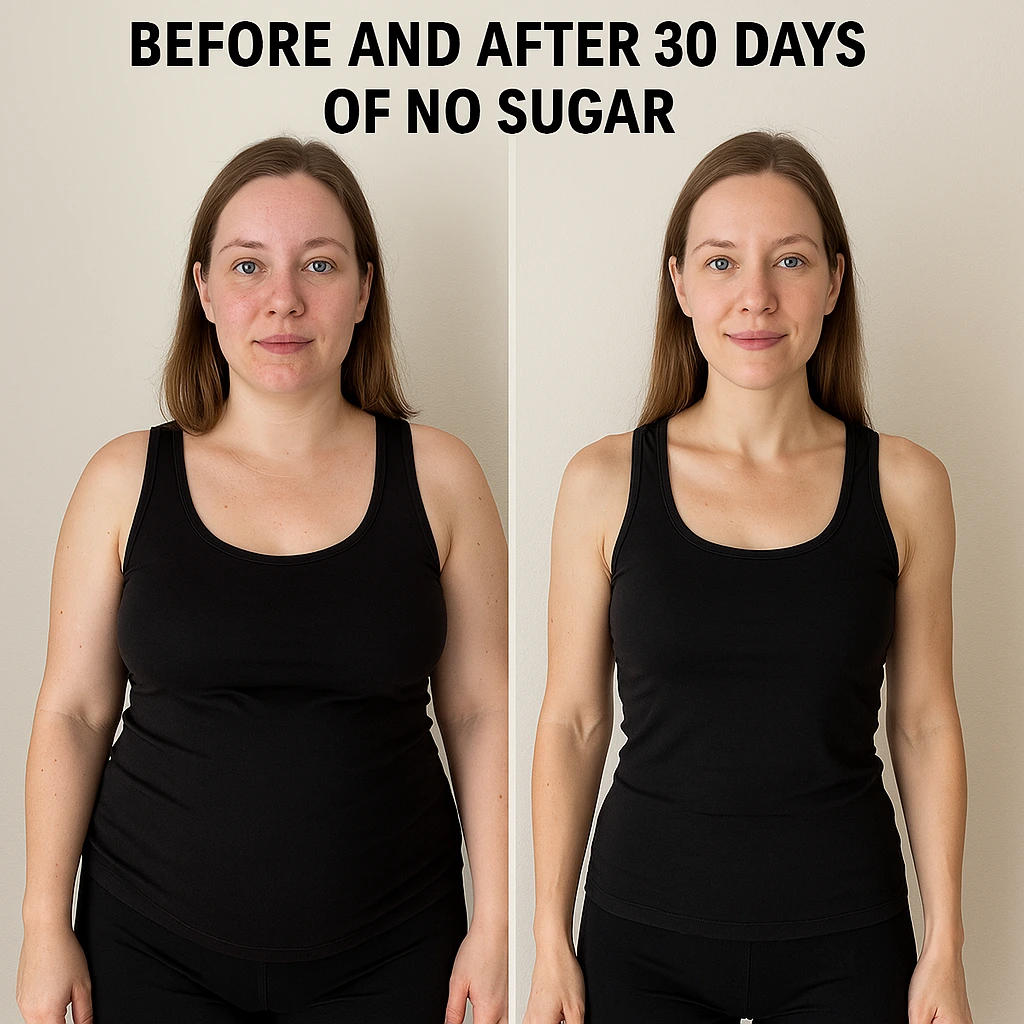Introduction
Are you curious about What Happens After 30 Days of No Sugar ? The Benefits of No Sugar for 30 Days are remarkable, ranging from weight loss and clearer skin to improved energy and mental clarity. Cutting out added sugars can reset your metabolism, reduce cravings, and even boost your mood. But what exactly occurs in your body during this transformative period? Whether you’re seeking a healthier lifestyle or simply want to explore the impact of a sugar-free diet, this guide will walk you through the science-backed results and inspiring transformations. Keep reading to uncover how a 30-day no sugar challenge can change your life!
1. Defining the 30-Day No Sugar Challenge
The 30-day no sugar challenge has become a popular trend for those seeking to improve their health and well-being. This challenge involves cutting out all added sugars for a full month, allowing participants to reset their relationship with food and experience profound physical and mental benefits.
1.1. Why People Are Trying It
From weight loss to clearer skin and improved energy levels, people are drawn to this challenge for its transformative potential. Many wonder What Happens After 30 Days of No Sugar? what happens when you don’t eat sugar for 30 days and how it can impact their lives.
1.2 Growing Interest in Sugar-Free Lifestyles
With rising awareness about the dangers of excessive sugar consumption, more individuals are exploring sugar-free lifestyles. Whether motivated by health concerns or personal goals, the challenge offers a structured way to break free from sugar addiction.
Table of Contents

2. What Happens After 30 Days of No Sugar?
2.1 Immediate Physical Changes
When you embark on a 30-day no sugar diet , your body undergoes significant changes both physically and mentally. The first few days might feel challenging, especially if you’re accustomed to consuming high amounts of sugar. During this time, your metabolism shifts gears, cravings intensify temporarily, and detox symptoms such as headaches or fatigue may arise. These initial hurdles are often referred to as “sugar withdrawal,” but they signal the beginning of positive transformations.
2.1.1 Stabilized Blood Sugar Levels
One of the most immediate physical changes is the stabilization of blood sugar levels. Without spikes and crashes caused by sugary foods, your body begins to rely on more consistent energy sources, such as fats and proteins.
2.1.2 Reduced Inflammation
Sugar is a known contributor to systemic inflammation. After 30 days without it, inflammation markers in the body decrease, leading to less joint pain, puffiness, and other related symptoms.
2.2 Mental and Emotional Benefits
Beyond physical changes, there are profound mental and emotional benefits. Many participants report feeling less irritable and more focused throughout the day, thanks to stabilized blood sugar levels.
2.2.1 Improved Focus and Concentration
Without the constant highs and lows of sugar-induced energy swings, cognitive function improves. Tasks that once felt overwhelming become easier to manage.
2.2.2 Enhanced Mood Stability
People frequently ask, What are the results of 30 days no sugar? The answer lies in these tangible benefits: enhanced physical health, better emotional balance, and a stronger sense of control over food choices.

3. Before and After: 30 Days No Sugar Transformation
3.1 Visual Transformations
One of the most exciting aspects of completing a 30-day no sugar challenge is witnessing the visible changes. Participants often share inspiring stories and photos showcasing their 30 days no sugar before and after journey. Visually, individuals notice brighter skin, reduced puffiness, and a healthier complexion due to decreased inflammation caused by sugar consumption.
3.1.1 Clearer Skin
Sugar contributes to acne and dullness by promoting inflammation and oil production. Cutting it out leads to clearer, glowing skin.
3.1.2 Weight Loss and Slimming Effects
Many participants experience weight loss, particularly around the midsection, which contributes to a slimmer appearance.
3.2 Internal Transformations
Beyond aesthetics, there’s a marked improvement in mood and energy levels.
3.2.1 Increased Energy
Physical stamina increases as the body adapts to using stored fat for fuel instead of relying on quick bursts of glucose.
3.2.2 Better Digestive Health
Reduced sugar intake often leads to improved digestion, as harmful bacteria in the gut that thrive on sugar are starved.

4. Weight Loss Potential Without Sugar
4.1 How Sugar Impacts Fat Storage
A major motivator for many embarking on a no sugar diet plan is its potential for weight loss. Added sugars are notorious for spiking insulin levels, promoting fat storage, and increasing hunger pangs. By removing sugar from your diet, you naturally lower insulin spikes, allowing your body to burn stored fat more efficiently.
4.1.1 Insulin Sensitivity Improvement
Studies show that abstaining from added sugars allows insulin sensitivity to improve, which is crucial for maintaining healthy blood sugar levels.
4.1.2 Reduced Cravings
Without sugar triggering cravings, you’re less likely to overeat or indulge in unhealthy snacks.
4.2 Realistic Weight Loss Goals
Research suggests that individuals following a strict 30-day no sugar diet can shed anywhere from 5 to 10 pounds, depending on factors like baseline weight, activity level, and adherence to the plan. Some achieve even greater losses, particularly if they combine the diet with regular exercise.
4.2.1 Factors Influencing Results
If you’re asking yourself, how much weight will I lose if I don’t eat sugar for a month? , know that consistency is key. Cutting out sugary snacks and beverages creates a calorie deficit while improving satiety through nutrient-dense alternatives.
4.2.2 Beyond the Scale
Ultimately, the goal isn’t just about shedding pounds—it’s about fostering sustainable habits that support long-term wellness.
5. What Happens After 14 or 21 Days Without Sugar?
5.1 Early Milestones
While 30 days is the standard timeframe for this challenge, shorter milestones like 14 or 21 days also yield impressive results.
5.1.1 Reduced Cravings
After two weeks without sugar, most people begin experiencing fewer cravings and improved digestion.
5.1.2 Energy Boost
Cravings diminish because the body adjusts to running on stable energy sources rather than quick hits of glucose.
5.2 Deeper Physiological Changes at 21 Days
At the three-week mark, deeper physiological changes occur. Insulin sensitivity improves further, and some individuals start noticing subtle weight loss and increased energy.
5.2.1 Enhanced Focus
Asking what happens after 14 days of no sugar reveals early signs of progress, including better focus and reduced irritability.
5.2.2 Improved Mood Regulation
Similarly, what does 21 days without sugar do? shows that consistency pays off, with participants reporting enhanced mood regulation and sustained motivation to continue.

6. The Long Game: No Sugar for 60 Days or 1 Year
6.1 Sustained Weight Loss
For those ready to take their commitment further, eliminating sugar for 60 days or even a year brings remarkable benefits. Physically, long-term abstinence from sugar leads to sustained weight loss, improved cardiovascular health, and reduced inflammation.
6.1.1 Cardiovascular Health
Lower sugar intake reduces the risk of heart disease by decreasing triglycerides and LDL cholesterol levels.
6.1.2 Anti-Aging Effects
Chronic conditions like fatty liver disease and insulin resistance may improve significantly, while aging processes slow down due to reduced oxidative stress.
6.2 Psychological Benefits
Mentally, individuals experience sharper cognitive function and greater resilience against stress.
6.2.1 Sharper Cognitive Function
Reducing sugar intake supports brain health, improving memory and focus.
6.2.2 Stress Resilience
Participants report feeling calmer and more capable of handling daily challenges.
7. Is It OK to Never Eat Sugar Again?
7.1 Debunking Myths
The question is it OK to never eat sugar again? sparks debate among nutritionists and health enthusiasts alike.
7.1.1 Natural vs. Added Sugars
While complete elimination isn’t necessary for everyone, drastically reducing added sugars aligns with nutritional science recommendations. Natural sugars found in fruits provide essential vitamins and fiber, making them a healthier alternative to processed options.
7.1.2 Balanced Approach
A balanced approach that includes natural sugars while avoiding added ones is ideal for long-term health.
8. The No Sugar and No Junk Food Crossover
8.1 Reducing Junk Food Intake
Quitting sugar often leads to reduced junk food intake, amplifying overall health benefits.
8.1.1 Breaking the Cycle
When you cut out sugary treats, cravings for other unhealthy snacks diminish too.
8.1.2 Cleaner Eating Habits
Discover what happens if you stop eating junk food for 30 days alongside sugar reduction, and you’ll find yourself embracing a cleaner, more mindful approach to eating.
9. Creating Your 30-Day No Sugar Plan
9.1 Practical Tips
To succeed, create a solid no sugar diet plan for 30 days . Start by cleaning out your pantry, replacing sugary items with healthier alternatives.
9.1.1 Pantry Cleanout
Remove all sources of added sugar, including sodas, candies, and processed snacks.
9.1.2 Sugar Alternatives
Use natural sweeteners like stevia or monk fruit as substitutes.
9.2 Sample Food List
Use a 14-day no sugar diet food list as a guide to stay on track.
9.2.1 Healthy Snacks
Include nuts, seeds, and fresh fruits in your daily meals.
9.2.2 Hydration
Drink plenty of water to curb cravings and stay hydrated.

10. No Sugar for 2 Weeks – A Realistic Start
10.1 Building Momentum
If the idea of 30 days feels daunting, start with no sugar for 2 weeks . Many see significant improvements in energy and mood within this timeframe, setting the stage for continued success.
10.1.1 Initial Results
Within two weeks, participants report reduced cravings, better focus, and improved digestion.
10.1.2 Motivation to Continue
Short-term successes often inspire individuals to extend their commitment beyond the initial two weeks.
Conclusion
In just 30 days of no sugar , your body can undergo transformative changes that extend far beyond weight loss. From stabilized blood sugar levels and reduced cravings to clearer skin, improved energy, and enhanced mental clarity, the benefits of no sugar for 30 days are both profound and scientifically supported. Whether you’re curious about what happens when you don’t eat sugar for 30 days or eager to see your own quitting sugar before and after transformation, this challenge offers a clear path to better health.
By committing to a no sugar diet plan , you’re not only resetting your relationship with food but also reducing inflammation, improving digestion, and lowering the risk of chronic diseases. And while the initial detox phase may bring temporary side effects, the long-term rewards—such as sustained weight loss and sharper cognitive function—are well worth the effort.
If you’re ready to take control of your health, start small or dive straight into the full 30-day journey. Remember, every step toward eliminating added sugars brings you closer to a healthier, more vibrant version of yourself. So why wait? Discover what happens after 30 days of no sugar and unlock the potential for lasting change today!
🧠 FAQ
Q1: What are the side effects of quitting sugar cold turkey?
Quitting sugar abruptly can lead to withdrawal symptoms like headaches, fatigue, and irritability as your body adjusts. However, these effects typically last only 5–7 days and signal your system recalibrating to healthier energy sources.
Q2: Can I eat fruit during the 30-day no sugar challenge?
Yes! Fruits are packed with natural sugars, fiber, and essential nutrients that nourish your body. Unlike refined sugars, they provide sustained energy and support overall health without spiking blood glucose levels.
Q3: What if I cheat during my no sugar challenge?
A slip-up doesn’t mean failure—simply acknowledge it, refocus, and continue your journey. Consistency over perfection is key, and every day you stick to the plan brings you closer to your goals.
Q4: How much weight can I realistically lose by not eating sugar for a month?
Most people lose between 5–10 pounds in 30 days, depending on factors like baseline weight, activity level, and adherence to the diet. Reducing sugar also helps curb cravings, making it easier to maintain a calorie deficit.
Q5: Will I gain the weight back after I start eating sugar again?
It’s possible, as reintroducing sugar may trigger cravings and overeating. To avoid this, focus on maintaining balanced eating habits and limiting added sugars even after the challenge ends.
Q6: What happens when you stop eating sugar for 14 days?
Within two weeks, most people notice reduced cravings, stabilized energy levels, and initial weight loss. These early milestones often motivate individuals to continue their sugar-free journey.
Q7: Is it realistic to follow a no sugar diet plan for 30 days?
Absolutely! With proper planning, a pantry cleanout, and mindful food choices, completing a 30-day no sugar challenge is entirely achievable. Many participants find the process rewarding, both physically and mentally.
Ready to transform your health? Start your 30-day no sugar challenge today and embrace the incredible benefits awaiting you!
You may also like:
What should I do immediately after running? A Complete Guide to Post-Run Recovery
What Happens When You Start Eating Healthier? A Complete Guide to Transforming Your Body and Mind
Mediterranean Salad Recipes: A Fresh Path to Health, Flavor, and Joy
Salad Recipes for Weight Loss: The Ultimate Guide to Healthy Eating and Wellness
Unlock the Benefits of Salad: Nutritional Power for Health, Wellness, and Active Living
High Protein Salad Recipes: The Perfect Fit for Health and Active Lifestyles
More relevant articles here >>>
More Health and Wellness salad recipes >>>
More Energy and Active Lifestyle salad recipes >>>
More Cultural and Seasonal Recipes >>>
References:
. “Impact of Sugar Reduction on Metabolic Health” by “Journal of the American Medical Association (JAMA)“
“Sugar Withdrawal Symptoms and Detox Effects” by Nutrition Journal
Weight Loss and Fat Storage Linked to Sugar Intake by Harvard T.H. Chan School of Public Health




